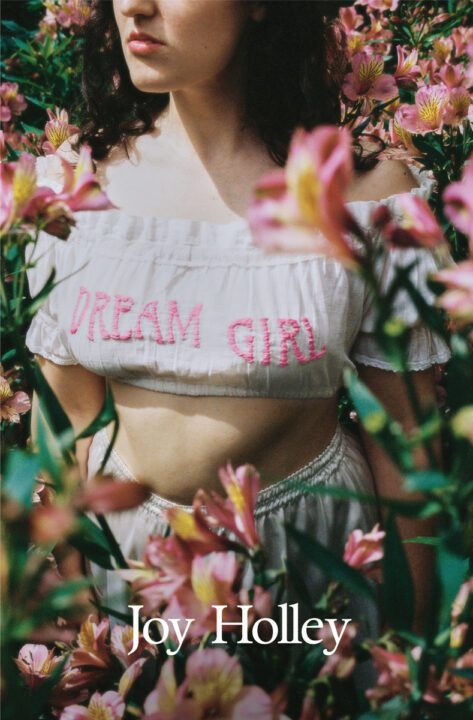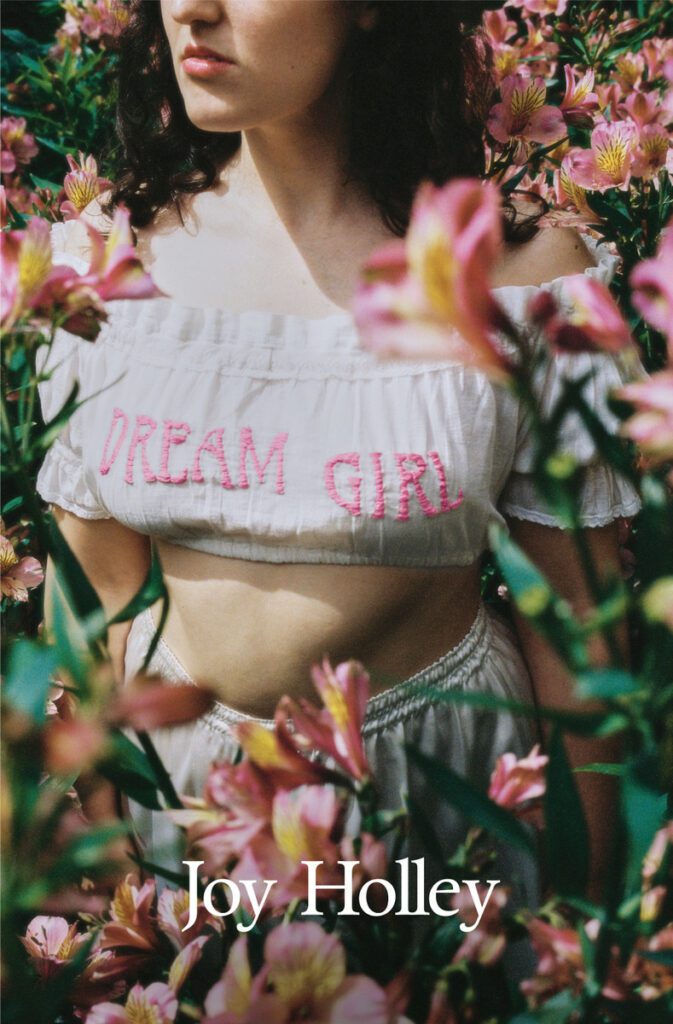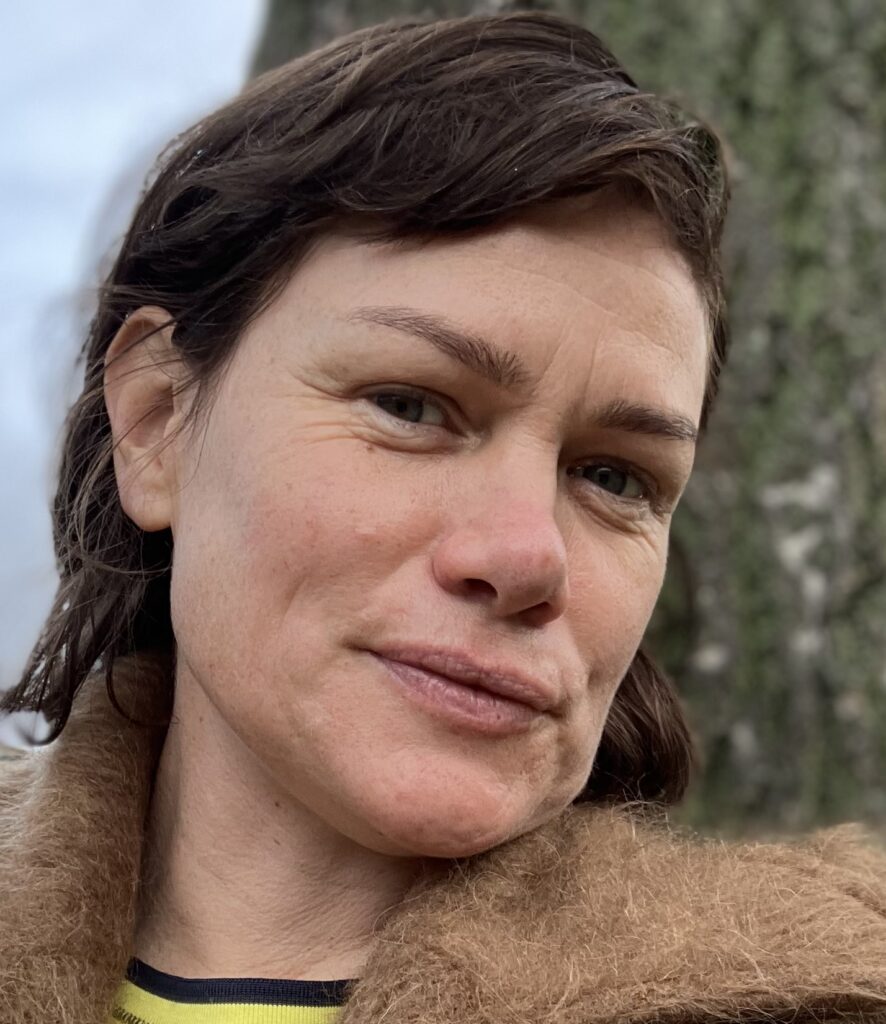Dream Girl

Dream Girl by Joy Holley. Te Herenga Waka University Press (2023). RRP: $30.00. PB, 236pp. ISBN: 9781776920846. Reviewed by Naomi Mary Smith.
When I was a kid there weren’t many lollies available at the cinema. Or maybe there were? But I only ever had eyes for tangy fruits. Much more than a sweet, each little ball was a new round of a private game you would play on your own in your mouth while the movie rolled by. Which flavour? Suck or chew? Share or hoard? A private world of spit, warmth, pleasure and melting sugar. A private world that in retrospect was pretty much the same for everyone.
This is what this collection of stories is like. We read a lot about fruit and mouths, and we roll around inside the heads of the many characters.
“[Alice] dreamed she was a girl in a white dress… eating pomegranates on a red picnic blanket.” (p. 51).
“I moved my tongue into Lena’s mouth, hoping she would bite it for me. The taste of cherry gin dissolved. Her mouth was sweet.” (p. 63).
“I loved the texture of citrus flesh on my tongue. I loved licking at the juice. When I bought a punnet of raspberries, I stuck them on my fingers and ate them one by one, like in Amélie. I cut up strawberries and placed them on a china plate, sprinkled with icing sugar. I ate passionfruits with a tiny spoon.” (p. 76).
The stories, admittedly, are not all sweet—but I wondered while reading them if, like the acid added to sugary confections to make them palatable, or the surface-only colour of those long ago tangy fruits, the variations between the stories in this collection aren’t just tweaks on a theme.
And the answer is, I don’t know.
The answer has to take into account that these stories are very much needed. When I was a young, queerying teenager (in 1994 or thereabouts) my mum lent me a book about a woman who traveled mystically through a damp-sheepskin-lined crack in a sacred cave, and teleported, or was reborn, or visioned herself from her own, woman-centric world to our one. She continued to walk around naked here as she did there with, well, consequences. And then in university I read Marge Piercy’s glorious Women on the Edge of Time (written earlier) and again (I say anachronistically) there was that untainted woman, her meeting us, and us meeting her. Both of us blinking. Her saying, really? Will you accept this? Is this good enough for you?
I imagine traveling back in time and giving myself this book, Dream Girl. At sixteen. At twenty. What a world-changing read it would be to me then. Girls. Dream girls. A world of girls. A collection of girls you can hold in your hand. Instead of reading “Death and the Maiden” aloud in a mixed gender classroom and stuttering over the word ‘orgasm’ in front of the other boys and girls and my male English teacher who was head of the department and took me to his office (alone) once, to talk about my attitude.
When we were kids we could say, ‘my favourite colour is …’ or ‘my favourite flavour is,’ but many of us do that as grown-ups for the same reason that, though I loved tangy fruits as a kid I probably wouldn’t enjoy them now.
It occurs to me in writing this that an even better analogy for Dream Girl is the Jelly Belly jelly beans that hit the shelves here in Aotearoa in the late 1980’s—the ones that had all kinds of flavours—from the intriguing and novel like apple pie, cinnamon and popcorn, through to thrillingly abject flavours like booger, barf, and stinky socks. We loved them as kids because they were daring and they reflected our messy pubescent world, taught us about our limits, and mixed sugar and spice and all things nice with snips and snails and puppy dogs’ tails.
There is a story in this collection that I think is one of the best, called Blood Magic. It is a blood flavoured story. A horror story. It hungrily cannibalises female-centric themes, as on page 179: “You picked her costume immediately… plastic tiara and white dress drenched in bright red blood… you’d watched Carrie for the first time the other day.” It’s unusual, and it’s wonderful. There are many stories in this collection that invoke horror themes – whether rats, ghosts or murder. But this story is the kind of writing of Holley’s that I want to read more of: longer form, singly focused, and imaginatively vast.
There was a repetitive and formulaic quality to some of the stories. Though it’s heavenly to enter a world populated almost entirely with dream girls, and for the most part leave the misogyny and homophobia of the world I know as the real world—maybe my generation’s world—behind, the dynamics here from story to story are too similar. But when these stories really work they’re so effective as to leave me feeling as if I’ve lived something rather than just read about it. I hope to read more—and hopefully longer and more challenging—Joy Holley stories in the future.
Naomi Mary Smith (Pākehā: Scotland (Thomson) and England), has been a costume maker, cook and teacher, and has more recently been working for whānau-driven initiatives in kaupapa Māori education including teaching reo Māori to adults at beginner and early intermediate level. She is currently living between London and Aotearoa and studying data science.

